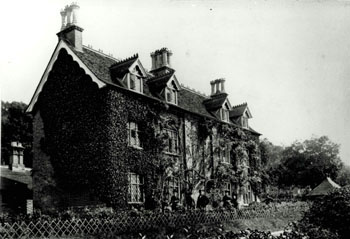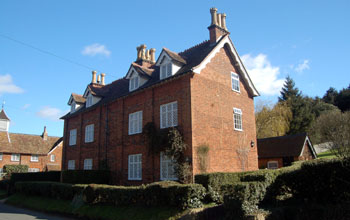
24 and 25 The Village about 1900 [Z50/129/111]
Under the original Poor Law of 1601, parishes collected a Poor Rate from those inhabitants not amongst the poor. This rate was collected and administered by a parish official - the Overseer of the Poor (larger parishes had more than one Overseer). He made disbursements of money or food and/or clothes to people who needed it. This was known as giving relief and this relief could be of two types. Outdoor relief was given to people who had their own lodgings and could maintain themselves in them with assistance. Indoor relief was granted to people who either had no dwelling, or were incapable of looking after themselves, this meant that they entered the parish poorhouse or workhouse.
When the word workhouse is used people normally think of the large, grim 19th century institutions housing hundreds of people in ways not dissimilar to a prison. Such institutions were created by the Poor Amendment Act of 1834. Before this individual parishes had their own workhouses, these could, no doubt, be grim but were usually not large.
24 and 25 High Street were previously the parish workhouse of Old Warden. No documents with Bedfordshire & Luton Archives & Records Service suggest how long this was the case, the earliest one being in 1835 when the premises were insured - interestingly the insurance document recorded that no cotton, wool, hemp or flax were worked nor oakum picked on the premises. The next year the premises were sold to the vicar, churchwardens and trustees of the Old Warden Charity Estate and Edward Peake's Charity in Old Warden. This was because the Biggleswade Union Workhouse had been set up and paupers from Old Warden were now sent there rather than going into the parish workhouse.

24 to 25 The Village March 2008
In 1876 the former workhouse was purchased by Joseph Shuttleworth from the vicar and charities and from the Official Trustee of Charity Lands for £700. It was then described as: "a house, formerly used as a workhouse, but now occupied as five tenements and a building on the south east side thereof for many years used as a parish schoolroom" [SL1/107].
Number 24 and 25 were listed by the former Department of Environment which described them as late 19th century "probably a reworking of an earlier building", which ties in with the information above. They have a four room plan of two storeys and attics. The Department of Environment noted: "Style is mixture of classicism and cottage ornée".
In 1927 the dwellings of Old Warden were valued under the Rating Valuation Act 1925; every piece of land and building in the country was assessed to determine the rates to be paid on it. The valuer visiting what are today 24 and 25 High Street [DV1/C34/98-101] found four dwellings, Numbers 22 to 25 The Village. All were owned by the Shuttleworth Estate and each stood in 0.185 of an acre. Number 22 was occupied by J.Palfrey and comprised a living room with a bedroom above and two further bedrooms in the attics; outside were a barn and earth closet. The valuer noted: "Decent size. Good. Was a workhouse made into 4 cottages. Impossible to measure because of inside arrangements. Covered with ivy. Pretty". Rent was £6 per annum.
23 The Village was in occupation of M.Milliner and comprised a living room with three bedrooms above; outside were a barn and earth closet. Like all the row water had to be fetched either from the pump outside Parsonage Piece or Jacob's Well. The valuer noted: "Talked to tenants they agree very little to choose between the middle and end ones". Rent was £6 per annum. Number 24 was the same as 23, though in occupation of C.Wheatley and 25 was the same as 22, though in occupation of S.Hare.